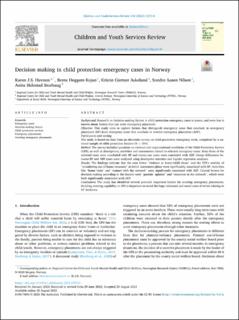| dc.contributor.author | Havnen, Karen J Skaale | |
| dc.contributor.author | Kojan, Bente Heggem | |
| dc.contributor.author | Askeland, Kristin Gärtner | |
| dc.contributor.author | Nilsen, Sondre Aasen | |
| dc.contributor.author | Storhaug, Anita Skårstad | |
| dc.date.accessioned | 2023-10-18T13:52:55Z | |
| dc.date.available | 2023-10-18T13:52:55Z | |
| dc.date.created | 2023-08-28T10:16:07Z | |
| dc.date.issued | 2023 | |
| dc.identifier.citation | Children and Youth Services Review. 2023, 154 . | en_US |
| dc.identifier.issn | 0190-7409 | |
| dc.identifier.uri | https://hdl.handle.net/11250/3097324 | |
| dc.description.abstract | Background Research on decision-making factors in child protection emergency cases is scarce, and even less is known about factors that can avert emergency placement. Objective This study aims to explore factors that distinguish emergency cases that conclude in emergency placement (EP) from emergency cases that conclude in averted emergency placement (AEP). Participants and setting The study is based on data from an electronic survey on child protection emergency work, completed by a national sample of child protection leaders (N = 154). Method The survey included questions on external and organisational conditions of the Child Protection Service (CPS), as well as descriptions, activities and assessments related to selected emergency cases. Sixty-three of the selected cases were concluded with EP and ninety-one cases were concluded with AEP. Group differences between EP and AEP cases were analysed using descriptive statistics and logistic regression analyses. Results The findings indicate that the case factor “violence at home/child abuse” and the CPS’s activity of “considering out-of-home measures” at initial assessment phase were significantly associated with EP. Activities like “home visits” and “contact with the network” were significantly associated with AEP. Crucial factors for decision-making according to the leaders were “parents’ opinion” and “resources in the network”, which were both significantly associated with AEP. Conclusions The study has identified several potential important factors for averting emergency placements. Building averting capability in CPS is important to avoid the huge relational and social costs of errors relating to EP decisions. | en_US |
| dc.language.iso | eng | en_US |
| dc.rights | Navngivelse 4.0 Internasjonal | * |
| dc.rights.uri | http://creativecommons.org/licenses/by/4.0/deed.no | * |
| dc.title | Decision making in child protection emergency cases in Norway | en_US |
| dc.title.alternative | Decision making in child protection emergency cases in Norway | en_US |
| dc.type | Peer reviewed | en_US |
| dc.type | Journal article | en_US |
| dc.rights.holder | © 2023 The Author(s) | en_US |
| dc.description.version | publishedVersion | en_US |
| cristin.ispublished | true | |
| cristin.fulltext | original | |
| cristin.qualitycode | 1 | |
| dc.identifier.doi | 10.1016/j.childyouth.2023.107141 | |
| dc.identifier.cristin | 2170101 | |
| dc.source.journal | Children and Youth Services Review | en_US |
| dc.source.volume | 154 | en_US |
| dc.source.pagenumber | 8 | en_US |

